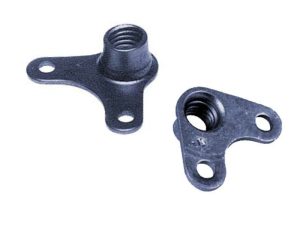
For some fastening applications, a traditional nut simply won’t cut it. Instead, you may need to use a nutplate. Also known as an anchor nuts, nutplates are fasteners with a threaded hole in the center. They are typically made of stamped sheet metal and support the use of rivets. You can secure a nutplate in place using a pair of rivets, after which you connect a bolt or similar threaded fastener to the center of it.
#1) Material
You should consider the material when choosing a nutplate. While most of them are made of metal, the specific type of metal from which a nutplate is made may vary. Some of them are made of stainless steel. Others are made of cadmium-plated carbon steel, allowing for a superior level of strength and durability.
#2) Rivet Holes
Don’t forget to consider the rivet holes when choosing a nutplate. Unlike traditional threaded nuts, nutplates have rivet holes. However, the location of these rivet holes may vary. There are V-shaped rivet nuts, such as those shown in the photo above, with a pair of off-centered rivet holes. Alternatively, there are nutplates with rivet holes to the left and right of the threaded center, as well as nutplates with rivet holes directly above or below the threaded center.
#3) Thread Size
One of the most important things to consider when choosing a nutplate is the thread size. Nutplates are designed for use with a bolt or similar threaded fastener — just like traditional threaded nuts. They feature a threaded hole in the center that supports a threaded fastener. The thread size, of course, represents the size of a nutplate’s threading. You’ll need to choose a nutplate in a thread size that matches the bolt or fastener with which you intend to use it.
#4) Fixed vs Floating
Are you looking for a fixed or floating nutplate? Most nutplates fall under one of these two categories. The difference between fixed and floating nutplates is that the latter allows the fastener with which it’s used to move slightly. With a floating nutplate, the fastener will move slightly, resulting in a greater tolerance. With a fixed nutplate, the fastener won’t move, resulting in a tighter tolerance.
#5) Open vs Capped
There are also open and capped nutplates available. Most nutplates are open, meaning they have a threaded hole in the center that doesn’t feature a back. Capped nutplates still have a threaded hole, but the threaded hole features a back. If you choose a capped nutplate, you won’t have to worry about the bolt or fastener damaging any adjacent parts. The back of the threaded hole will prevent the fastener from accidentally striking the parts around it.



